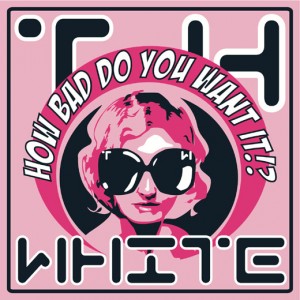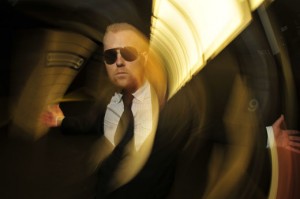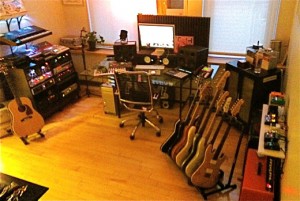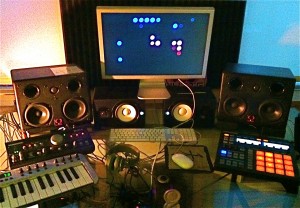Leading the Electronic Charge: T.H. White and the Habit-Forming "How Bad Do You Want It"
UPPER EAST SIDE, MANHATTAN: Beyond duplicity, there’s multiplicity – the invigorating state occupied by T.H. White.
An unabashed New York City brat born, raised, and constantly amazed by Manhattan, the DJ/producer has kindly returned the WoW with his new album, How Bad Do You Want It? An addictive adventure, track after track after track of How Bad is a jam, combining the best attributes of electronica, a big psychedelic streak, natural-born instruments, and instinctual songwriting.
After first exposure, trying to get it out of your mind/body is useless, so why resist? Better to groove with White’s Thievery Corporation-smart flow, densely informed by his training on drums and guitar, a degree in audio engineering, remix commissions for the likes of Phenomenal Handclap Band and Faunts, synch licensing selections for “The Sopranos” to BMW and Reebok, and composing for commercials. See what we mean about multiplets?
His M.O. is clear when the conversation kicks in. “I feel my natural tendency is to bring a Pink Floyd approach to electronica/modern music,” explains the hyperactive White from his Upper East Side studio, a creative pod in a 130-year-old loft building. “Meaning: I like flushed out ‘pieces’ that reveal an emotional sequence or story. With this LP I had in mind my own Animals with super-modern beats, synths, and guitar sounds based on an urban American sensibility.”
Clubs to Control Rooms
After starting out as a club goer and player – he paid his dues playing live everywhere from Wetlands to CBGB and Club U.S.A. – White got all educational on his assets. He stumbled on a prehistoric edition of Pro Tools at a friend’s studio and felt a new shock pierce his brain, one that would lead him to eventually earn an audio degree from The New School. The resulting scientific know-how affected T.H. heavily, and helped distinguish him as a diversely adept artist.
“A lot of people in the music world have written and moaned that with today’s technology it’s ‘too easy’ and ‘No soul’…FALSE,” White says. “First of all, if your ideas suck, they suck. No computer is going to fix that. Maybe a lot more people are willing to try to cut a record now — but you still need talent, development and guttural passion. That will always separate the men from the boys.
“I believe if you learn this technology the way a concert pianist learns the piano, you will learn how to extract the ‘soul’ and ‘heart’ from technology. That’s why I took the time to study engineering and technology: to move ahead with the times, and really learn how to express my ideas.”
In the creation of How Bad, along with his three previous albums, 2005’s More Than Before, 2007’s The Private Spotlight, and the 2009-spawned Company BookWhite conscientiously applied what he calls “the three age-old engineering concepts”:
(1) Work very hard to get amazing sounds before you commit anything to tape/disk
(2) Never leave anything to be fixed in the mix
(3)Learn the inherent frequencies to the various instruments you work with – this will allow you to look ahead to the mix, before you have even started boosting and stripping specific kHz’s so that tracks don’t compete with each other.
“The best producers in the world hand over albums that a pro mixer will need to do very little to,” explains White. “These are the things I always have in my mind when I’m in the studio.
“What does all this amount to? I feel that today you need to be a writer/ musician/ engineer/ producer and mixer if you really want control of your ideas and want to set yourself apart.”
Plugged-in Studio. Music First.
Although a citizen of TriBeCa, White makes a daily pilgrimage to the culturally sleepy (Museum Mile excepted) Upper East Side, where he created 80% of How Bad’s tracks at his hybrid analog/digital room. Drums, cellos, organs and other highly live components are cut at outside studios, after which White returns to edit, process and integrate these organic recordings with what’s percolating in his Crystal Method-addled mind.
On his 500 sq. ft. home court, White takes advantage of the natural ambience that the 130-year-old wood in his loft lends to miking guitars, synths and vocals. He also benefits from the tasty processing of custom Hit Factory gear. Among the tech benefits: an Avalon VT-737 with custom-made tubes and wiring, and a Universal Audio 6176 channel strip with custom tubes.
While hardware is important to White, he knows it starts with the music. How Bad’s rhythms can be reminiscent of the live tribalism achieved by electronic intelligentsia Yello, whose real percussion and drums merge in unexpected ways with samples and sequences.
“The first instrument I was formally trained in was drums, starting with lessons at eight years old,” he notes. “Percussion rhythms and their role on music is in my blood. I favor a process of going to old-school vintage studios, setting up a rich live drum kit and room, then jamming for hours and putting that all on tape. I then go back to my studio and process, chop and edit that tape to compile my own custom library that I use.
“Sometimes I take an entire loop, other times just a dope snare. I also layer and layer drum tracks to further create depth and originality. An example of this from the new LP is the song ‘How it Feels’: that track has me playing a live kit on top of a drum machine loop I programmed, and then layered with additional samples.”
No slouch on the six-strings, White often achieves a dark sense of tension throughout How Bad with the use of patient guitars on songs like “Down in the Garden.” The result is a subtly natural feel that takes this circuit-inspired album far from the in-the-box territory.
“Although the genre I operate in is usually called ‘electronic’, I’ve always used my abilities as a guitarist/bassist and live drummer to be more than that,” says White. “Guitars can be so sonically rich, and they are not linear like most synths are. Also I am a gun-blazer on guitar: I would love to sit in with The Allman Brothers, The Grateful Dead, or Phish as a representative from my genre – I think that would be unique and refreshing. I have the experience and skills on guitar and try to show that in the right spots in my own music.
“I own 13 guitars and, like the drums, I employ a blending through a wide variety of tube pedals, EQ’s, amps and plug-ins to polish guitar tracks. One example is ‘Down in the Garden’ which is a PRS hollowbody on one side, and an ‘82 Les Paul on the other. Add in a TC Electronic G4 and some Lexicon reverb, and you’re starting to talk business.”
Remixing, Synch Licensing and Other Daring Stunts
White works the DJ angle in the studio by making himself available for remixes. A visit to his Website makes it easy to hear why he gets the calls from Phenomenal Handclap Band (“All of the Above”), Faunts (“Memories of Places We’ve Never Been”), and Fol Chen (“Cable TV”). If White sounds inspired by his assignments, well, there’s a good reason for that.
“I have to like their music to start,” he says of his remix work. “Then it’s vibe – meaning, ‘Do I hear my style and ideas working well and complementing the original track?’ Most of the mixes I’ve done have been for artists who approached me and felt synergy there. In terms of approach, I almost always use several of the original tracks- but highly reprocess and treat them. Another thing I do is write and play new parts on guitar or bass.
“It’s always good to get inside someone else’s session, see how they’ve recorded and organized their song, and the way they’ve EQ’d things. I really enjoy having a template that I had nothing to do with to build off of – it’s refreshing.”
As most producer/artists are now wont to do, White is increasingly active in music-for-media. In addition to the aforementioned synch licenses for “The Sopranos,” BMW, and Reebok, White’s songs have been chosen for SyFy Channel’s “Being Human,” Fox TV’s “The Inside,” and NPR radio.
Despite his composing and synchronization successes, White admits that he’s keeping a wary eye on developments in the sector, as noticeable downward pressure on pricing reveals itself.
“I think it’s still a grey area in terms of corporate association or ‘selling out,’ and finding a way for your hard work and passion to support its own continuation,” notes White. “The gruesome aspect is that as media companies have seen the decline of music sales — and that leading to an increased need for artists to turn to synch — music directors are offering much-less-to-no-money for uses.”
Manhattan Attack
With a year-long diet of live jaunts scheduled, White is looking forward to leaving the studio for a second and returning his “Hendrix-meets Deadmau5” live show to the stage. Wherever he shows up, however, expect all audiences to get a big blast of the Big Apple, courtesy of a multi-tasking electronic explorer who just can’t get NYC out of his system.
“No matter who you are or what your passion is, the center of that passion is in New York City,” T.H. White points out. “One can find so much inspiration and diversity in that inspiration here. Growing up, I had the opportunity to study with premier musicians, play live shows at real venues, intern at big studios, see a large spectrum of artists. I remember one three-week period when I was in 11th grade I saw Eric B. and Rakim, Fugazi, Merle Haggard, Kiss, Dee-lite and Buddy Guy. That’s what I’m talking about.”
— David Weiss










